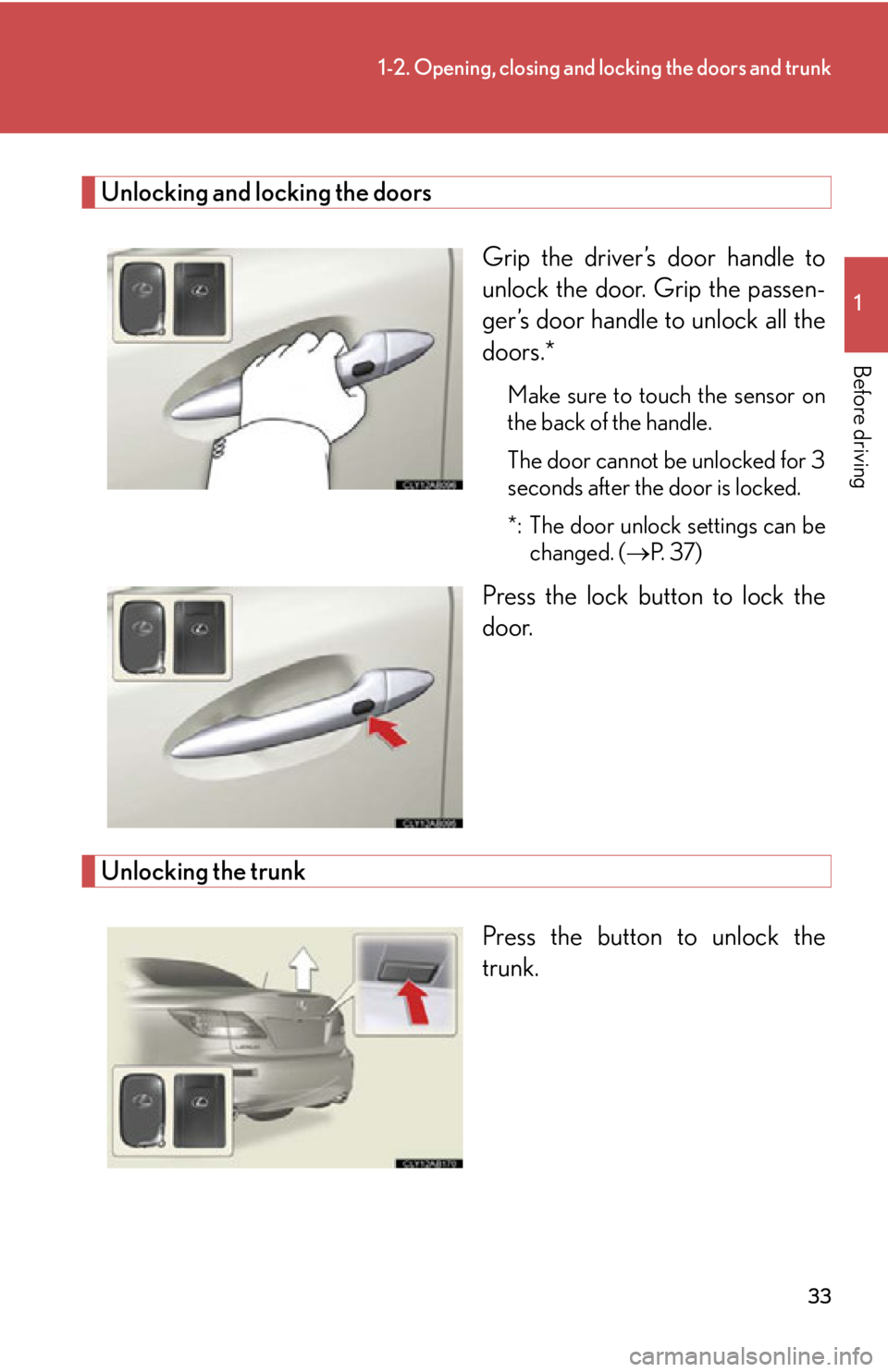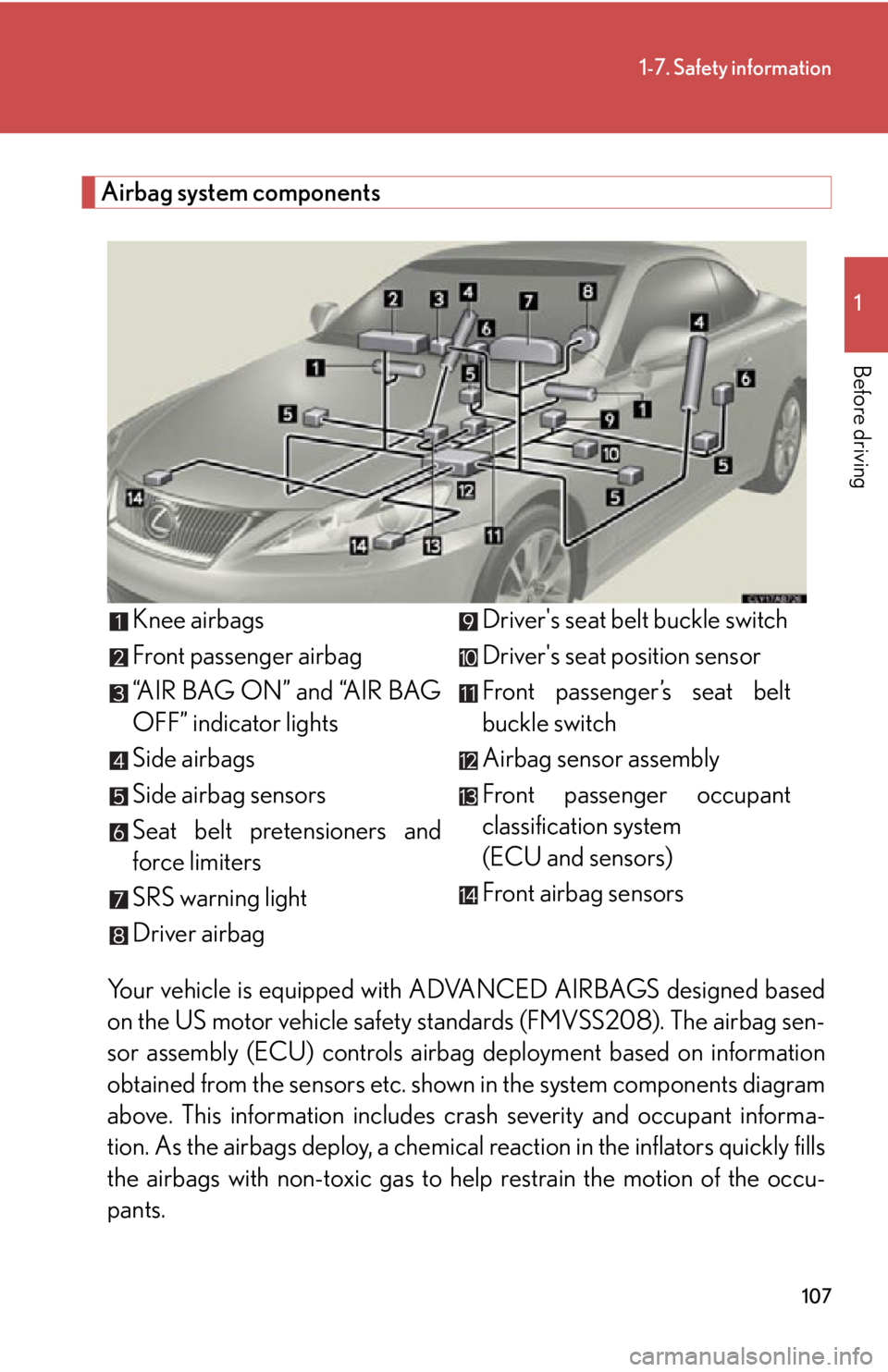2013 LEXUS IS250C sensor
[x] Cancel search: sensorPage 33 of 624

33
1-2. Opening, closing and locking the doors and trunk
1
Before driving
Unlocking and locking the doorsGrip the driver’s door handle to
unlock the door. Grip the passen-
ger’s door handle to unlock all the
doors.*
Make sure to touch the sensor on
the back of the handle.
The door cannot be unlocked for 3
seconds after the door is locked.
*: The door unlock settings can bechanged. ( P. 3 7 )
Press the lock button to lock the
door.
Unlocking the trunk
Press the button to unlock the
trunk.
Page 72 of 624

72
1-3. Adjustable components (seats, mirrors, steering wheel)
Seat belt pretensioners (front seats)
The pretensioner helps the seat
belt to quickly restrain the occu-
pant by retracting the seat belt
when the vehicle is subjected to
certain types of severe frontal colli-
sion.
The pretensioner may not activate
in the event of a minor frontal
impact, a side impact, a rear impact
or a vehicle rollover.
Pre-collision seat belts (front seats of vehicles with pre-collision system)
If the pre-collision sensor detects that a collision is unavoidable, the pre-
collision system will retract the seatbe lt, thus enhancing the effectiveness
of the seat belt pretensioner in a crash.
The same will happen if the driver ma kes an emergency braking or loses con-
trol of the vehicle. ( P. 222)
■Emergency locking retractor (ELR)
The retractor will lock the belt during a sudd en stop or on impact. It may also lock if
you lean forward or pull out the belt too quickly. Allow the belt to fully retract, and
then slowly extend the belt. If the belt cannot be pulled out of the retractor, firmly
pull the belt and release it. You will then be able to smoothly pull the belt out of the
retractor.
■Automatic locking retractor (ALR)
When a passenger's shoulder belt is completely extended and then retracted even
slightly, the belt is locked in that position and cannot be extended. This feature is
used to hold the child restraint system (CRS) firmly. To free the belt again, fully
retract the belt and then pull the belt out once more. ( P. 1 2 6 )
Page 74 of 624

74
1-3. Adjustable components (seats, mirrors, steering wheel)
CAUTION
Observe the following precautions to reduce the risk of injury in the event of sudden
braking, sudden swerving or an accident.
Failing to do so may cause death or severe injury.
■Wearing a seat belt
●Ensure that all passengers wear a seat belt.
●Always wear a seat belt properly.
●Each seat belt should be used by one person only. Do not use a seat belt for more
than one person at once, including children.
●Lexus recommends that children be seated in the rear seat and always use a seat
belt and/or an appropriate child restraint system.
●Do not recline the seat any more than necessary to achieve a proper seating
position. The seat belt is most effective when the occupants are sitting up straight
and well back in the seats.
●Do not wear the shoulder belt under your arm.
●Always wear your seat belt low and snug across your hips.
■When children are in the vehicle
Do not allow children to play with the seat belt. If the seat belt becomes twisted
around a child’s neck, it may lead to choking or other serious injuries that could
result in death.
If this occurs and the buckle cannot be un fastened, scissors should be used to cut
the belt.
■Seat belt pretensioners
●Do not place anything, such as a cushion, on the front passenger’s seat. Doing so
will disperse the passenger’s weight, wh ich prevents the sensor from detecting
the passenger’s weight properly. As a resu lt, the seat belt pretensioner for the
front passenger’s seat may not activate in the event of a collision.
●If the pretensioner has activated, the SRS warning light will come on. In that case,
the seat belt cannot be used again and must be replaced at your Lexus dealer.
■When using the seat belt guide
Always make sure that the belt is not twisted, and runs freely through the guide.
■Before fastening the rear seat belt
Release the seat belt holder.
Page 78 of 624

78
1-3. Adjustable components (seats, mirrors, steering wheel)
Anti-glare inside rear view mirror
■To prevent sensor error
CAUTION
■Caution while driving
Do not adjust the position of the mirror while driving.
Doing so may lead to mishandling of the vehicle and an accident, resulting in death
or serious injury.
In automatic mode, sensors are used to detect the headlights of vehicles
behind and automatically reduce the reflected light.
Turns automatic mode on/off
The indicator comes on when
automatic mode is turned on.
The anti-glare mirror default
mode is automatic. The anti-
glare mirror is automatically set
to automatic whenever the
“ENGINE START STOP” switch
is turned to IGNITION ON
mode.
To ensure that the sensors operate properly,
do not touch or cover them.
Page 90 of 624

90
1-4. Opening and closing the windows and retractable hardtop
Retractable hardtop operation control linked to the intuitive parking
assist (vehicles with an intuitive parking assist)
This function detects if there is an ob struction behind the vehicle and reg-
ulates retractable hardtop operation according to the vehicle’s distance
from that obstruction.
This function is merely de signed to assist the driver and is not a guarantee
of the safety of the ar ea behind the vehicle. The driver should always
check the vehicle’s surroundings with their own eyes before operating the
retractable hardtop.
■ Operation controls according to each detection area
Area within approximately
1.2 ft. (35 cm) of the vehicle
Area approximately
1.2 ft. (35 cm) to 1.5 ft. (45 cm)
away from the vehicle
Areas within approximately
0.8 ft. (25 cm) of the vehicle
Areas approximately
0.8 ft. (25 cm) to 1.3 ft. (37.5
cm) away from the vehicle
This function only operates in the
areas indicated in the illustration.
Therefore, obstructions too close
to the sensors cannot be detected.
●If an obstruction is d etected in area or when the switch is oper-
ated
A buzzer will sound and a message will be shown in the multi-informa-
tion display to alert the driver.
If the switch is held up or down for 3 seconds while the message is being dis-
played, retractable hardtop operation will start normally.
Page 92 of 624

92
1-4. Opening and closing the windows and retractable hardtop
■When a message appears and the retractable hardtop does not operate
Check the message contents and perform the recommended procedure, then
operate the switch again. (P. 5 0 3 )
■Retractable hardtop operation control linked to the intuitive parking assist
●This function will activate when th e intuitive parking assist is on. (P. 3 6 5 )
●Once the trunk lid has been fully opened, this function will be disabled.
●The trunk lid can be closed even when an obstruction is detected by operating
the retractable hardtop operation sw itch in the opposite direction.
■If the intuitive parking assist is dirty or malfunctioning
If a message is shown in the multi-information display indicating that a sensor is mal-
functioning or needs to be cleaned, th e retractable hardtop cannot be operated
normally. To start retractable hardtop operation, turn the intuitive parking assist off
and operate the switch for the retractable hardtop again, or hold the switch up or
down for 6 seconds or more. In this case, retractable hardtop operation control
linked to the intuitive parking assist-sensor will not function.
■Customization that can be configured at a Lexus dealer
Setting of the intuitive parking assist linked function can be changed.
(Customizable features P. 5 8 6 )
Page 107 of 624

107
1-7. Safety information
1
Before driving
Airbag system componentsYour vehicle is equipped with AD VANCED AIRBAGS designed based
on the US motor vehicle safety st andards (FMVSS208). The airbag sen-
sor assembly (ECU) controls airbag deployment based on information
obtained from the sensors etc. show n in the system components diagram
above. This information includes crash severity and occupant informa-
tion. As the airbags deploy, a chemica l reaction in the inflators quickly fills
the airbags with non-toxic gas to he lp restrain the motion of the occu-
pants. Knee airbags
Front passenger airbag
“AIR BAG ON” and “AIR BAG
OFF” indicator lights
Side airbags
Side airbag sensors
Seat belt pretensioners and
force limiters
SRS warning light
Driver airbag
Driver's seat belt buckle switch
Driver's seat position sensor
Front passenger’s seat belt
buckle switch
Airbag sensor assembly
Front passenger occupant
classification system
(ECU and sensors)
Front airbag sensors
Page 108 of 624

108
1-7. Safety information
■SRS warning light
This warning light system monitors the airbag sensor assembly, front airbag sensors,
side airbag sensor assemblies , driver's seat position sensor, driver's seat belt buckle
switch, front passenger occupant classifi cation system (ECU and sensors), “AIR
BAG ON” indicator light, “AIR BAG OFF” indicator light, front passenger’s seat
belt buckle switch, seat belt pretensioner assemblies, airbags, interconnecting wir-
ing and power sources. ( P. 4 9 2 )
■If the SRS airbags deploy (inflate)
●Bruising and slight abrasion s may result from contact with a deploying (inflating)
SRS airbag.
●A loud noise and white powder will be emitted.
●Parts of the airbag module (steering wheel , airbag cover and inflator) as well as
the front seats may be hot for several minu tes. The airbag itself may also be hot.
●The windshield may crack.
●For Safety Connect subscribers, if the SRS airbags deploy or in the event of a
severe rear-end collision, the system is designed to send an emergency call to
the response center, notifying them of the vehicle’s location (without needing to
push the “SOS” button) and an agent will attempt to speak with the occupants
to ascertain the level of emergency and assistance required. If the occupants
are unable to communicate, the agent automatically treats the call as an emer-
gency and helps to dispatch the necessary emergency services. ( P. 3 8 7 )
■SRS airbag deployment conditions (SRS front airbags)
●The SRS front airbags will deploy in the event of an impact that exceeds the
set threshold level (the level of force corresponding to an approximately 12 -
18 mph [20 - 30 km/h] frontal collision wi th a fixed wall that does not move or
deform).
However, this threshold velocity will be considerably higher if the vehicle strikes
an object, such as a parked vehicle or sign pole, which can move or deform on
impact, or if the vehicle is involved in an underride collision (e.g. a collision in
which the front of the vehicle “underrides”, or goes under, the bed of a truck, etc.).